Ever since we started composting back in 2008 at our old house, we’ve enjoyed doing it (snaps for free fertilizer, reusing “trash,” and getting some subtle encouragement to eat more compost-able foods). But our composting adventures have been somewhat limited by the size of the DIY compost container that we made 3 years ago (we did eventually make a second bin, but it’s nothing like those bigger composting systems that we’ve seen at stores or in DIY magazines).

Even back in 2008 when we created our little bin, I initially wanted to make a more “legit” system out of shipping pallets (like I read about here and here) but hunting down and transporting a bunch of bulky pallets was a bit more than I was ready to sign up for. So I figured starting off with a bin and later graduating to something more built-in might be the way to go. And now just three short (ok, loong) years later, thanks to our patio supplies having arrived on pallets, I finally had my excuse to upgrade our compost system. It just took us a few months to decide where we wanted our new bin to sit. We finally agreed on this corner:

In case you need a clearer reference point, here’s that little not-at-all-to-scale map of our yard (the house is way too big and the almost-an-acre yard is much too small) that Sherry whipped up (marked with an arrow where we added our little “compost station”):
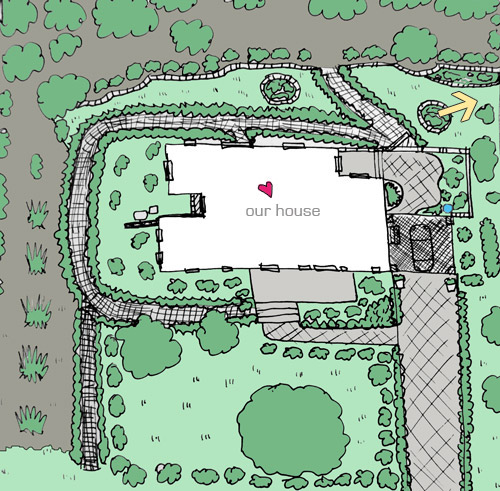
We picked that spot because:
- it was fairly hidden from view
- it didn’t disrupt the landscape very much (i.e. it wasn’t in the middle of the grass or anything)
- it was convenient enough to get to without being right against the house (we know compost isn’t supposed to smell – and our old bin never did – but we didn’t want to risk getting whiffs of nature’s miracle at work if this system was any different).
- the only “landscaping” that we’d be sacrificing was some ivy and a few weeds (how will we ever live with ourselves?)
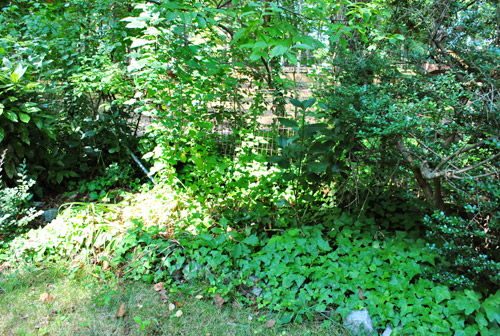
One perk to losing some of the ivy is that I uncovered some unexpected treasures in the process, like this ancient Hooters frisbee and a random plastic tire. Looks like this upgraded composting system is already paying off in major free-stuff dividends.
After a bit more work with my shovel and rake, I was eventually left with this clearing. Some of the online instructions that I googled around for suggested putting an extra pallet down for your base, while I read others who complained that a pallet on the ground made turning the compost a big ol’ pain (picture pitchfork tongs or shovels getting stuck between the slats). Some others even suggested a slanted base to help collect the tea (the nutrient-rich “run off” from your compost pile), but I just opted to keep things simple and make my life easy – at least for now. So this flat square of dirt did the trick:
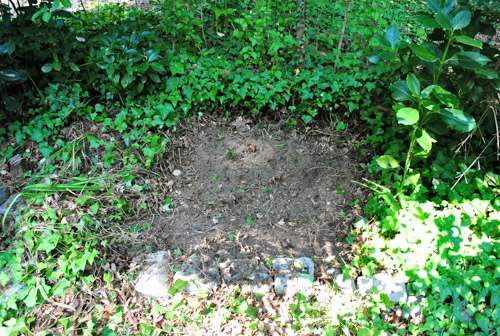
With my area cleared, I gathered my supplies:
- Three shipping pallets (which I was thrilled to finally move out of our basement)
- A few 2″ wood screws
- Electric screwdriver
- Work gloves
- Shovel
Fortunately these were all things we already owned, so our project cost rang in at a big fat goose egg. Even better than a free project? The whole thing only took me about 20 minutes (not counting photo-snapping time). Which was a nice unexpected surprise. Remember, I go into all small projects expecting them to take forever and throw me ten curve balls so I don’t get my quick-project hopes dashed by an obstacle or two (which I’ve learned are par for the DIY course). So yeah, it was awesome that this quick and easy project really was quick and easy.
First I dug a small trench (about 4″ deep) at the back of the compost area so that my pallet had a little groove to stand in while I secured the other sides:
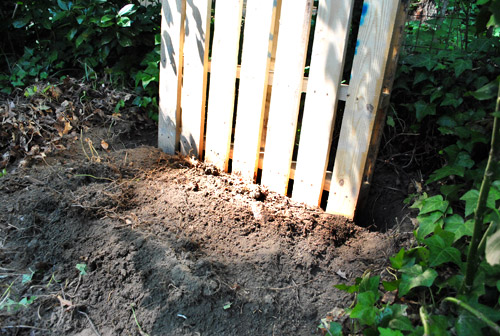
Then I put the second pallet next to it to create one side:

Notice how the side with the more closely-spaced slats faces in (otherwise we’d get lots of compost spilling through). But that doesn’t mean you should use a completely solid piece of wood (the slatted pallets help air circulate, which helps the decomposing process while also keeping odor down).
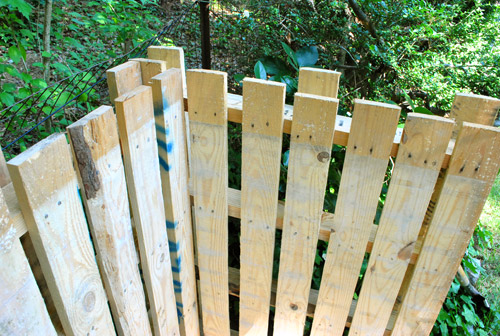
To secure the pallets together, I just drilled three screws (one in the top, middle, and bottom) to connect the two pallets. Some tutorials that I read called for zip ties instead, which I’m not surprised to hear (they, like duct tape, can accomplish almost anything). I just had screws on hand, and since that was another recommended method I went for it. I also enjoy projects a little more when I get to break out my power tools (I can almost feel Sherry rolling her eyes at this sentence). The funny thing is that the pallets were practically sturdy enough to stay together on their own so the screws kinda felt like a formality, but they were nice “insurance” so I’m glad I took a moment to add them (and say hi to my drill).
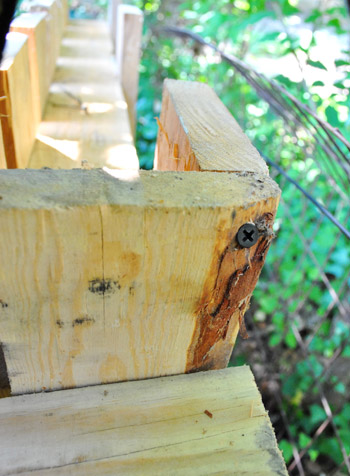
Then I rinsed and repeated the whole joining shebang with the third pallet on the other side.
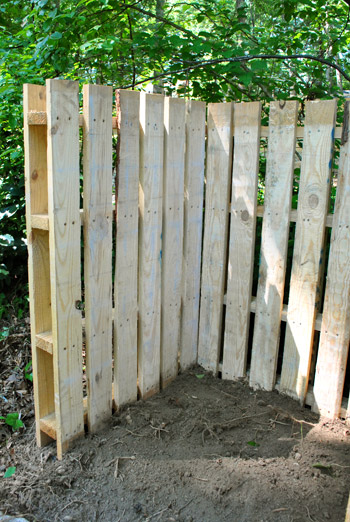
Then, um… ta-dah? That was pretty much it. Some of the instructions that I read included using a fourth pallet to create a hinged door in the front (I guess a fifth if you added an extra pallet on the bottom). I wasn’t inclined to do this because (1) that seemed more complicated than I wanted to get into – at least off the bat, and (2) I didn’t have any hinges on hand. Initially I was just going to leave my bin open-sided and not stress if my pile started to migrate a bit beyond its three borders…
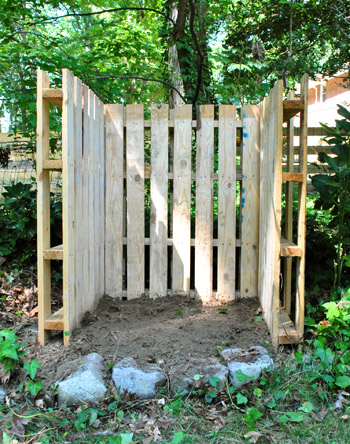
… but I realized it probably wasn’t the best idea in practice, especially since it was on a slight slope and one big rain could wash our pile-o-decomposition into the yard. Gross. So I improvised a bit and found a nearly-perfectly-sized piece of scrap wood that could act as a fourth wall (with the help of two leftover wood stakes). It stays in place just fine and can easily be picked up when it’s time to turn our pile (or grab a big heaping batch of nurtrient-rich soil when it’s ready).

As the pile grows, I’m thinking I could easily upgrade my system with a few more boards stacked up or a taller piece of wood with taller stakes or poles to hold them flush against the pallets. But this’ll do for now:
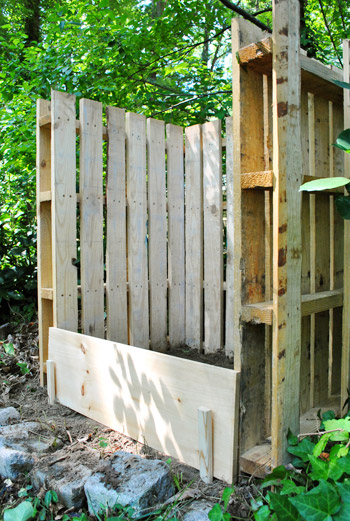
And to kick off the competition composition, I threw in a layer of nice brown leaves from the backyard. Ooooh. Ahhh.
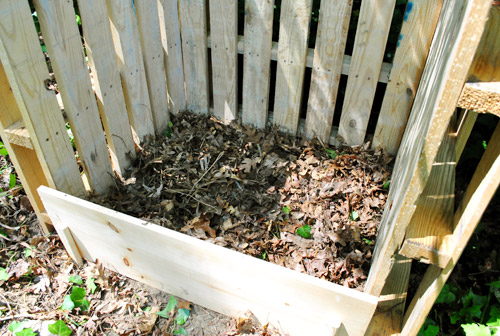
Now we’re the first to admit that we’re still kind of novices at this whole composting thing. Even after three years of doing it. I’ve thrown out references like “turn the pile” as if I know what we’re supposed to do (and how often and why) but I’m really just going off of tidbits that we’ve picked up online. When it came to our old system we just stirred things when we tossed in a pile o’ stuff (we had a lidded plastic container that we kept under the sink for compost scraps and emptied that into the bin twice a week or so). And we printed out a list of compostable stuff and taped that to the inside of our under-the-sink door near the compost container so we could consult that if we didn’t know if something could be added. So admittedly I’m not quite Captain Compost yet (so if anyone has any pointers or resources for us, we’re all ears). The good news about compost is that it seems to just do its own thing for the most part (you can read about a few of our experiences with it over the years here, here, here, and here). We’ve never had any issues with smell or anything, so it’s a pretty painless auto-pilot process.
Oh, and I should mention that if anyone is hesitant about using wood that might be chemically-treated (like pallets) for their bin, you can limit your use of the resulting compost to non-edible plants (i.e. use it in your flowerbeds, not in an herb or veggie garden). That’s definitely what we’ll be doing just in case. We’re a bit late in the season to have much usable compost this year anyway (darn, no accidental pumpkin growing for me this Halloween) but hopefully next year we’ll have more free fertilizer than we’ll know what to do with. And maybe some of that ivy will have grown around the pallets to help it “blend” in a bit more. You know, so we end up with a charming secret garden compost situation. Of course we could also stain or paint the palettes to help them blend in (dark green, brown, gray, etc). We’ll keep you posted.
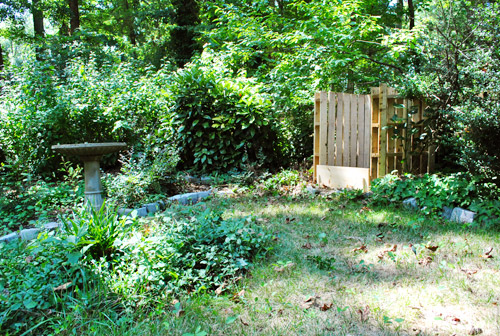
Do any of you have a pallet compost bin (or other composting system) going on at your place? How has it been working out? Anything you think we should know as we start this new chapter in our composting lives? Has anyone else accidentally grown a pumpkin? That’s my crowning composting achievement thus far.
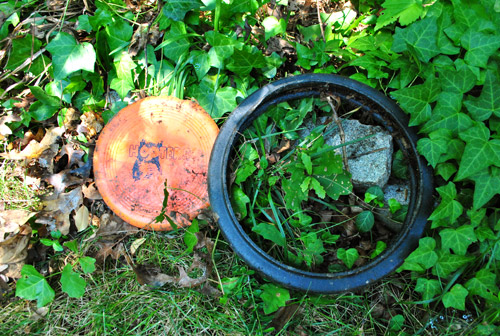

Monique says
I’m a composting novice. I found an article about compost in the wintertime. Apparently it can be done but the temperature in the pile has to be kept at above freezing. Here’s the link on winter composting http://www.hgtv.com/decorating/winter-composting/index.html
I live in the midwest so I doubt this is doable for me but maybe those in a warmer climate will be successful.
I wonder if you will be able to turn your compost pile when your pile becomes larger. If so, any suggestions on how to accomplish? I’d love to have a huge compost pile but I don’t think I could turn a pile as large as half the bin you have there.
YoungHouseLove says
We used to use a shovel or rake to turn out big tupperware bins (we turn it every time we add stuff, which is usually a few times a week) so we hope we can keep that up! We’ll check back with an update to tell you how it goes!
xo,
s
Tara G. says
Perhaps Sandy’s post would be helpful: http://reluctantentertainer.com/2010/06/5-compost-bin-get-your-free-palates-now/
YoungHouseLove says
Wow- that’s quite a system! Thanks for the link!
xo,
s
Cassity @ Remodelaholic says
We used some old fence sections, that we pulled off the side of the road about 3 years ago. Looks about the same as the pallets. It has been fabulous. Our garden this year has produced about 200 lbs minimum of totally organic produce- for practically nothing! Keep it up it totally pays off for your plants!
Megan says
I did a pallet compost system too! 3 Bins and made them have hinged doors.
http://53rdst.blogspot.com/2011/05/completed-compost-bins.html
Amy E. says
my parents have had a compost bin in their garden for almost as long as i can remember. they actually set it up right IN the garden area so that instead of turning, they just move it to a different spot in the garden every couple of years and move the excess compost to the new spot. it leaves a nice layer of composty-topsoil where it used to be. they used chicken wire for 3 sides, and wood slats stacked on top of eachother (threaded down grooves in a couple of 4x4s) to keep the 4th side closed. they put in everything from food peels to lawn trimmings and even pulled weeds! (which sometimes just lets the weeds take root in the compost; but hey, at least they’re not in the lawn/garden!)
Lauren says
Quick-project hopes: guilty! And I’d like if my compost could be ready a week or so later, too. Yours must break down quickly in Richmond heat? But what about snakes? Eeee…..
Would love to have the space for a proper system like this – but we have two worm compost bins on our balcony instead. Easiest pets ever!
Kitty says
I’ve never accidentally grown a pumpkin, but I did manage to accidentally grow a watermelon from a second story window. See, my brother and I were having a seed spitting contest and one of us managed to get one up there somehow. By the end of the summer there was actually a tiny watermelon hanging in front of the kitchen window. Guess we should have cleaned the leaves out of the window sills!
YoungHouseLove says
Haha- that’s pretty amazing!
xo,
s
Kathleen says
I love my composting bin! It’s not made out of pallets, but rather a DIY project of wooden stakes and some chicken wire. During the summer I add a little water to it just to keep it moist and the worms happy. I’ve never accidentally grown a pumpkin, but have frequently found volunteer tomatoes and potatoes in my garden.
Dawn says
This is great! We’ve been talking about doing this, using the pallets we got when we ordered our patio stones—–so it was really funny to read on your blog today that you had done it. I think this may be next on our to-do list! Thanks!
Lizl says
I cannot wait to start this project. A friend of mine is coming to plant a food garden at our house soon. So one of these days I will be a recycling, green, composting person! Love it!
Lindsay says
I’m really excited about this post. I won’t be making one quite so big, but I’ve been wanting to start composting for a while now. Thanks!
Lyn says
I love the idea of using old pallets!! I am reading this and looking at my garden and my mind is thinking of all the possibilities!
We used two LARGE plastic round bins and screwed them together for our composter and cut an opening in one end. We recently bought a 55 gallon barrel that we will mount on a frame and use this year.
Speaking of volunteers, we had several cherry tomato plants come up this year as well as cantaloupe. As long as my dog doesn’t eat the tomatoes we are getting a good harvest this year!
I’ve enjoyed reading your ideas today. A friend of mine told me about your blog, I will be back!
Blessings!
Lyn
Elizabeth says
I haven’t read all of the comments, so I’m not sure if anyone has made this suggestions…. But first, you definitely made the best composting ‘bin’- my friend spent a ton of his peacecorps time working with compost and a 3 walled wooden structure is his best suggestion. You mentioned possibly adding on to your composting system in the future. If you ever do decide to do so consider adding two more walls to make a Second bin using one existing wall between the two ‘bins’. This would be best because as you have a pile that is further along in its composting cycle you would be best off to start an entirely new pile and let the furthest along pile finish turning to nice dirt. Just a down-the-road suggestion to consider.
Also, as many people are concerned about animals, rodents bugs what have you, you seem to already know the only real “rules” for compost are No Meat or Dairy and you’ll be golden in the way of pests. But if you care to rinse your eggshells those can be added to your pile! Happy Composting.
YoungHouseLove says
Thanks for the tips Elizabeth!
xo,
s
Katrina says
I just read the old bedbug post that you linked to this site this week, which is ironic, because today my husband called me (from out of town on a work trip) to inform me he thought he had bedbug bites on his arm! We took a lot of your advice, so hopefully we won’t have them transfer to our house (if they were even bedbug bites in the first place!) Thanks for sharing (and linking again) your story!
YoungHouseLove says
Oh no! Good luck!
xo,
s
Red says
My parents have been composting for years. About fifteen years ago, they switched to a three-bin system. They compost everything (including dairy, eggs, meat, bones, etc.). At any given time, one bin contains “ready-to-use” compost, one contains “in process” compost, and the third is the “new” compost.
They built the bins with concrete blocks (the 8x8x12″ kind) and Mom layers in soaker hoses as the “new” bin fills up (and when the “in process” bin becomes the “ready-to-use” bin, she just tugs the hose out). The “in process” and “ready-to-use” bins are topped with pallets and the “new” bin with a heavier metal lid (actually, the hood of a truck). This serves two purposes: 1) it keeps the critters out and 2) it identifies which bin is the “new” bin. Also, having built them with blocks makes them fairly portable (they’ve moved these things to different locations on the farm at least twice due to new projects going in where they were located).
Occasionally, one of the farm dogs, coyotes, fox, or pack rats gets into the bin and takes off with something, but not often, even with the so-called non-compostables in there. And even the new bin doesn’t smell. Actually, the 2-gallon bucket they keep under the sink to put the compostables in smells worse than the bin (they do the bucket so they’re not constantly going out to the bins, they only make about one trip a week, depending on how much Mom’s cooking). And Mom’s 50×50 foot garden is AMAZING; she actually sold several hundred pounds of veggies – mostly leafy varieties like lettuce, kale, and chard – to one of the local restaurants one summer.
YoungHouseLove says
Wow- that’s amazing! Your mom sounds like an awesome gardener!
xo,
s
Teri says
A few years ago, I grew an avocado in our compost heap (really, less of a bin, more of a pile). Amazing because I don’t live in Sunny Florida or California. Nope. J’habite a Nashville. As in TN. As in cold-as-frack in the winter. But, now I know you can grow an avocado here (at least for a little while).
YoungHouseLove says
No way! That’s amazing!
xo,
s
Lindsay says
Hey guys,
We have composted off and on my whole life and we just moved into a house with a backyard big enough to have a compost pile and a garden. We bought a huge compost bin at Home Depot for $30 and it is hidden in the back corner, it has a bottom trap door you can shovel out the good stuff and keep dumping fresh stuff on top. I love composting, I never feel guilty for tossing out the over ripe fruits and veggies, it is awesome! Love the vacuum tip!
Ray says
Coffee Grounds. My wife turned me on to the blog after the Popcicle stick fiasco story, but I love most of your posts.
A few people have told me coffe grounds. Even if you don’t use them ask others for them. Apparently the nutrients in used coffee grounds can create a lot of heat, even in fall and spring to help really break that stuff down and does not give off as offenseive a smell as long because of the time it will cut out of decomposing grass and leaves.
Susan says
Check out this post on compost with some useful links:
http://newblog.susiesgarden.com/2010/02/about-that-compost.html
YoungHouseLove says
Thanks!
xo,
s
Libby says
My neighbour had fabulous compost. He used to pee on the heap every day. Yup. I think his wife did too, but gave him a container rather than doing the act on site.
YoungHouseLove says
Wow, that’s hardcore. Haha.
xo,
s
Alison says
We made our bin using these brackets:
http://www.leevalley.com/US/garden/page.aspx?p=56092&cat=2,33140
We followed the suggestion to leave a couple boards unscrewed, so it’s easier to get at the pile for turning. Simple, and somewhat attractive (for a compost bin). It’s amazing how quickly the scraps break down!
Liz says
We just started a compost bin made from three pallets – virtually identical to yours.
In my experience, pallets are almost never (and maybe never) made from treated wood. They will usually rot away after several years… bad because you need to build a new bin, but it’s a good indication that they’re not made from pressure-treated lumbar and they’re safe for compost bins.
Laura says
This is great. I have always wanted to create a compost pile in my one-day backyard, and this is such a budget-friendly green idea. I love that it keeps it well hidden. I will have to try this!
Karima says
I have a similar compost system in my backyard, and I have been composting for 3 years. As long as you don’t dump any dairy products and meat/fish leftovers, the pile never smells and I have not seen any animals either.
It is amazing however how little trash we have now. We probably reduced our “trash footprint” by 75% along with recycling.
I think composting should be made mandatory! :)
Kaitlin says
Hey, I was wondering, now that you’re almost 9 months into having your new compost bin, if you have any problems with smell? Our yard isn’t as big as yours, and I really want to compost, but my husband is concerned that it will stink, and that we’ll have animals picking through our kitchen scraps and making a mess. Any issues with these? How often have you been turning? Thanks!
YoungHouseLove says
No smell issues! Just don’t put dairy or meat in there and it’ll do great! Even when I’m standing there mixing stuff in there’s no smell. We turn every time we dump something (maybe 2-3 times a week).
xo,
s
haverwench says
Our pallet bin is similar to yours, but with a fourth pallet attached to the front on swivel hinges. We opted for a closed box because our bin is *right* against the house–so we don’t even have to keep a compost bucket in the kitchen, we can just step out the side door and dump stuff right in the bin. And no, no problems with odor.
We use strictly the “cold compost” method (which sounds more sophisticated than the “lazy” method). We don’t bother with layering, and we barely even turn the pile. Just throw everything in willy-nilly. It breaks down slowly, but it does break down.
Our accidental squash vine, grown in our third year of composting, was a butternut rather than a pumpkin. It was huge–took over the whole side yard–and yielded probably a dozen squashes. Seriously, we got a bigger harvest from this volunteer plant than from any crop we’ve ever grown on purpose. Which is really disappointing, because when we tried planting butternut squash in a spot where we actually wanted it, we got nothin’.
Rachel says
Could you guys do an update on this? I’m curious about what happens to the compost in the winter, did you guys cover it? Also since your new system is open if you experienced any smells or critters? Thanks!
YoungHouseLove says
We just leave it out year round. It doesn’t break down to make compostable soil as quickly over the winter but then when it warms up it’s at it again. No critter issues or smells at all :)
xo
s
Mary Pesavento says
I have always loved your blog! The website that I posted is my daughter’s new blog and she mentioned composting yesterday and I had remembered your composting blog :) I guess it’s the time of the season. Of course I looked up how to decorate a composting bin for new ideas to share.
YoungHouseLove says
So sweet! Thanks Mary!
xo
s
John says
Glad I found this! My dad has wanted to make one of these for awhile now. It looks pretty simple and cheap. Maybe a family project is in the works this summer. Thanks for the info.
Ellie says
How did this compost bin end up working out? Are you planning on or have you already created a composting system at the new house?
YoungHouseLove says
It was great! Wish we could have brought it with us. Now we just have a casual pile in the woods, but I want to make a bin again someday!
xo
s